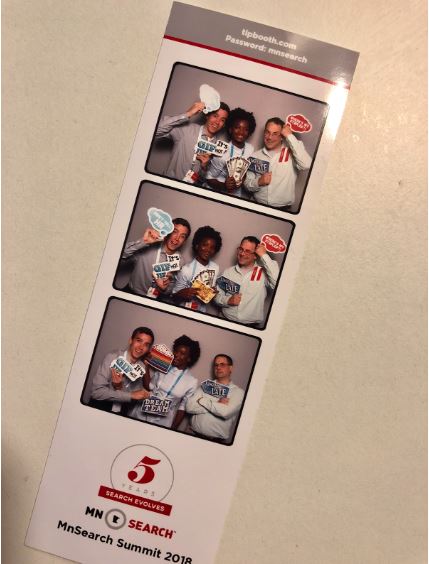I emerged from MnSearch Summit 2018 smitten with Power BI. Six months on, what have I done from MnSearch lately? This post is the first in three that aims to cover the implementation of tactics from MnSearch. It’s an honest take on what changes I’ve made post-conference.
Power BI will revolutionize your marketing
Wil Reynolds’ talk on Power BI was marketing inspo. His call to set up your own benchmarks with your own data spoke to me. I cannot tell you  how many times I’ve referred to that HubSpot post on benchmarks. If anyone is ready to use their own data for benchmarking, it’s me.
how many times I’ve referred to that HubSpot post on benchmarks. If anyone is ready to use their own data for benchmarking, it’s me.
Power BI (turboNet if you’re on a MAC) is a free Analytics tool that allows you to create custom dashboards and reports pulling from various data sources that are in many a digital marketer’s toolboxes. Power BI gives you the power to analyze PPC and SEO data on an aggregate and micro level across all of your campaigns, ad spend, organic rankings, search queries, devices etc.
Wil compared Power BI to Excel Pivot Tables on steroids.
Power BI for PPC Marketers
The tool can help you:
- Tie snippets to paid data to find keywords that convert and to pull which snippets rank better for landing page content insights
- Pit top converting vs. top ranking keywords across thousands of key terms and search queries so you can build landing pages to match top converting keywords
Power BI for SEOs
The tool has benefits for search engine marketers too, besides marrying organic and paid data on one dashboard, SEOs can:
- Find ranking opportunities (when powered with a rank crawler like getting Stat) to see which keywords that Google is not ranking for
- Pull keywords that you rank for with “please” in the query (via Google Search Console) to find voice search opportunities
I wanted all of that.
Power BI Implementation is as slow as molasses.
After MnSearch all my boss heard was Power BI. Wil and his team created a video series that touches on the basics. It’s a starting point, but much like other tools out there, Power BI is something you have to dive in and test for yourself play with.
Have we implemented it yet? No *hides face* Check back in 3 months.
Using Analytics to Garner Blog Content Insights
Jeff Sauer is the Google Analytics master in my orbit, and he has spoken extensively about how we need to go beyond the basics that Analytics offers to gain further insight.
I typically walk away amazed at all the cool ways he hacks GA to find insights such as how long should my blog posts be, and how do different audience segments respond to different posts.
Creating content is work. We spend a lot on content videos, email, and blog posts. I’m proud of our motley crew of bloggers and content producers spanning from Technical Products team to the marketing team. However, I can do a better job of analyzing our content to give them insights on the results of their efforts beyond just sessions and goal conversion.
In preparation for my favorite time of year, creating our quarterly blog calendar update (which to me is like going to the gym for 4 hours straight after skipping 3 months), I used Jeff’s content analysis to put together segments on our blog to help me analyze how our content performs.
Result: It’s like 100 burpees, don’t even try.
Just kidding, Jeff distills his Analytics wizardry in this 2015 Moz post.
There are three options for implementing content groups if you are super -comfortable with GTM that seems like a pretty good way to go.
I had help creating GTM tags by Author create a Blogger leaderboard of which author generated the most sessions for the blog (not a ton of insight but a fun way to gamify our blog’s meetings).
On my own, I went with the easiest implementation using Page Title and Page Content to build the groups. It’s super easy even a non-tech marketer like me can handle it.
Bhet why do this?
I get it, I’m kinda lazy about customizing my Analytics set up beyond the basics, and my inbox is flooded too. That said a one-time set up will give you a lot of cool insights.
Here are some of the ways of segmenting your audience can help you:
- Create content groups based on information that’s relevant to you (e.g. word count, publish date, author, topics)
- Breakdown conversion rate form the blog by creating segments of visitor type for comparison, e.g. Leads vs. Non-leads, Repeat Customers, Most Engaged Customers (Super Fans). This can help you create content that hits different customer segments and gives you a picture as to how your content performs for the buyer’s journey. But also measure who is engaging with your content.
- Use content groups to analyze what visitors do next in Behavior Flow reporting. Tying groups with Behavior flows will allow you to follow paths that users reading that type of content will fall into.
Pick something that would be helpful to know and try the easiest route.
MnSearch Snapping Back to Reality
The “Post-Summit 2018: What Have I Done Lately” is series covering what we’ve implemented after all the takeaways from the conference back in June. We’ll be back in a few weeks, hopefully, the guilt of having accomplished so little will inspire (read: coerce) me to close outlook for a few hours a week and GSD.
Speaking of, what have you implemented post MnSearch Summit 2018? Please share! I’d love to hear, be inspired and feel guilty for doing so little.
***
ABOUT DAISY
 Daisy is a Digital Marketing and Content Manager for a Midwest e-commerce company by day and a personal style consultant by night. When she’s not working, writing, rifling through vintage racks or attempting to crack jokes on an amateur stand-up stage, she can be found trying to write a better bio so she sounds super cool on the interwebs.
Daisy is a Digital Marketing and Content Manager for a Midwest e-commerce company by day and a personal style consultant by night. When she’s not working, writing, rifling through vintage racks or attempting to crack jokes on an amateur stand-up stage, she can be found trying to write a better bio so she sounds super cool on the interwebs.
Twitter – @daisyquaker
Linkedin – https://www.linkedin.com/in/daisyquaker